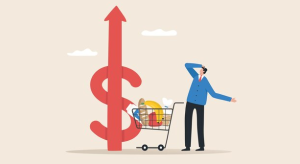The increasing rate of inflation has profound implications for Americans, as it directly affects their purchasing power. Understanding these impacts is crucial for making informed financial decisions and safeguarding one’s economic well-being.
In recent years, the United States has experienced fluctuating inflation rates, causing many to become concerned about the diminishing value of their money. This blog delves into how rising prices influence the ability of consumers to buy goods and services.
The influence of inflation on consumer buying strength

Inflation erodes the value of currency, making it more expensive for individuals to purchase the same amount of goods or services over time. When the cost of living rises, each dollar effectively buys less, which impacts consumers across various sectors. Higher inflation rates can lead to increased prices on everyday items, from groceries to housing.
The decline in purchasing power also affects savings and investment returns. For example, if the inflation rate surpasses the interest earned on a savings account, the real value of the savings decreases over time. This poses a challenge for people trying to build wealth or save for future expenses.
Additionally, wage growth often fails to keep pace with inflation, resulting in a real decrease in income. This disparity means that even if nominal wages increase, the real purchasing capacity of those wages might not, leaving families with less disposable income to cover their expenses.
Price increases and essential commodities
Essential commodities such as food and gasoline are often the first to see price hikes during periods of inflation. When these basic necessities become more expensive, it has a trickle-down effect on individuals’ overall financial stability. For example, higher fuel prices can increase transportation costs, which businesses may pass on to consumers through higher prices for other goods and services.
Moreover, rising food prices can lead to difficult choices for low-income families, who may have to prioritize between buying enough to eat and covering other essential expenses such as medical bills or rent. This can create a cycle of financial instability that is difficult to break.
Impact on borrowing and lending
Inflation can significantly impact borrowing costs as well. When inflation rises, central banks may increase interest rates to control the economy. These higher interest rates make loans and mortgages more expensive for consumers. Increased borrowing costs can deter significant investments such as purchasing homes or cars, which depend on affordable credit.
On the flip side, higher interest rates can benefit savers, as they might receive better returns on savings accounts and certificates of deposit. However, the overall benefit depends on whether these returns outpace inflation. If not, the real value of their nest egg may still diminish.
The delicate balance between controlling inflation and maintaining accessible credit markets poses a constant challenge for policymakers. Keeping inflation in check while ensuring economic growth requires careful planning and monitoring of financial indicators.
Long-term effects on the economy
Sustained high inflation can lead to more profound economic challenges, including slowing economic growth. As businesses face increasing costs for raw materials and labor, they might scale back expansion plans, which can stifle job creation and economic mobility. Further, investors may become wary of inflationary environments, preferring stability when making long-term investments.
This hesitance can slow capital inflows into innovation and infrastructure, both of which are essential for a growing economy. Inflation also impacts international competitiveness. If domestic inflation outpaces that of other countries, American products become more expensive abroad, potentially reducing export demand. This can exacerbate trade imbalances and affect industries reliant on a global customer base.
Strategies for mitigating inflation risks
There are several ways individuals can shield themselves from the adverse effects of inflation. Firstly, diversifying investments can help. Assets such as real estate, stocks, and commodities tend to perform better during inflationary periods, providing a hedge against decreasing purchasing power. Another strategy involves investing in inflation-protected securities.
These financial instruments, such as Treasury Inflation-Protected Securities (TIPS), are designed to increase in value alongside inflation, offering a safer way to preserve capital. Finally, maintaining a budget that emphasizes essentials and cuts down on non-essential spending can help manage rising costs. By prioritizing needs over wants, families can navigate financial turbulence more effectively.
The role of government policies
Government policies play a significant role in managing inflation and mitigating its effects on purchasing power. Fiscal measures, such as adjusting tax policies or offering subsidies on essential goods, can relieve some of the burdens faced by consumers. Monetary policies, such as controlling the money supply and setting interest rates, are also crucial tools used by central banks to stabilize the economy.
These policies aim to manage inflation expectations and maintain economic equilibrium. Public awareness and education on financial literacy can empower individuals to make better decisions. Understanding how inflation works and its impact on personal finances is a critical step toward adapting and thriving in an ever-changing economic landscape.
